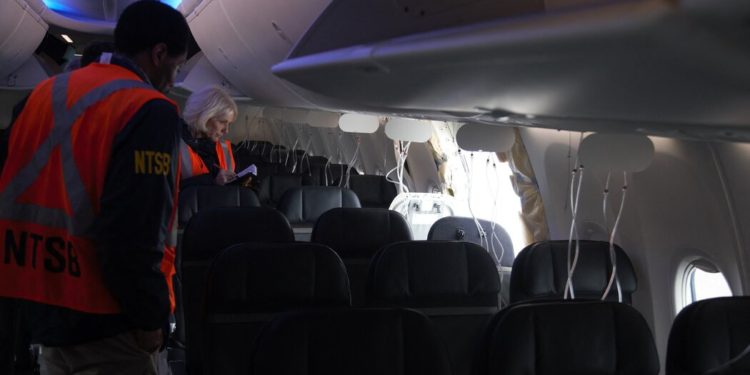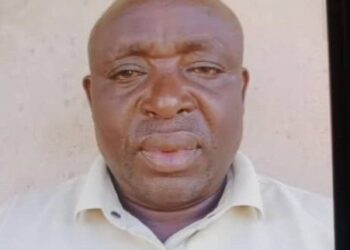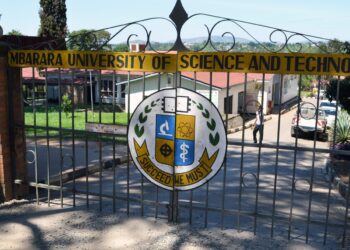By THE NEW YORK TIMES
Investigators have identified several questions as they try to get to the bottom of what caused a part of a Boeing 737 Max 9 plane to be blown out in midflight on Friday, including about how a critical component was installed. Their work is expected to carry on for weeks.
The questions include whether Alaska Airlines, which operated the flight from Portland, Ore., appropriately handled pressurization warnings aboard the plane, including two in the two days before the blowout. The investigation, led by the National Transportation Safety Board, is also focusing on the installation and inspection of the piece of the plane that was ripped out — a plug where an emergency exit door would have been if the jet had more seats.
“I think investigators are going to be focused on the manufacturing process of this particular airplane,” said Jeff Guzzetti, a former investigator for the N.T.S.B. and the Federal Aviation Administration. “How was this door plug installed or who installed it?”
The door was initially installed by Spirit AeroSystems, which makes the body for the 737 Max and other aircraft. Investigators said they were looking into whether any work had been carried on the door or in that area of the plane since it entered service in November.
United Airlines said on Monday afternoon that it had found some loose bolts in door plugs on its Max 9 planes during preliminary inspections that began over the weekend. The airline said it was still waiting for final F.A.A. approval of the process to begin required inspections.
The airline said it had carried out its own inspections on most of its Max 9 planes, a process that involves removing two rows of seats and a “sidewall liner,” since Saturday. Each inspection involves five United technicians working for several hours.
Jennifer Homendy, the chairwoman of the N.T.S.B., said investigators had a great deal of work to do, including inspecting the plug, which was recovered from a backyard in Portland. The board will also examine a plug that remained intact on the other side of the plane, interview flight crews and passengers, review maintenance records and repair logs, and conduct laboratory analyses of parts from the plane.
Investigators are also likely to look into whether the installation of wireless internet equipment on the plane by a contractor, AAR, between Nov. 27 and Dec. 7 played any part in the pressurization problems, which emerged after that work was complete. In a statement, AAR said on Monday that it “did not perform any work on or near any midcabin exit door plug of that specific aircraft.”
While no serious injuries were reported, the accident could have been far more catastrophic, especially if the plane — which had taken off 10 minutes earlier and made an emergency landing back in Portland — had been at a higher altitude, experts said. Ms. Homendy said on Sunday night that the passengers had included three babies and four unaccompanied children between the ages of 5 and 17.
Anthony Brickhouse, a professor of aerospace safety at Embry-Riddle Aeronautical University, said a blowout at a cruising altitude of more than 30,000 feet could have been disastrous. “We could have been looking at a situation where more of the structure could have come off and would have been looking at a situation where passengers who weren’t strapped in properly would have been blown out because the forces would have been so tremendous,” he said.
Pressurization starts to affect most commercial planes around 8,000 feet, said Mr. Brickhouse, who previously investigated aviation accidents for the safety board. Not properly controlling the air entering and leaving the cabin can lead to altitude sickness, or hypoxia, among passengers and the crew.
Hypoxia, a condition that develops when the brain is deprived of oxygen, can happen on planes without appropriate pressurization when they begin flying above 10,000 feet or suffer rapid decompression, the F.A.A. says. This is why flight attendant tell passengers to use drop-down masks in the event of rapid decompression, Mr. Brickhouse said.
The episode has led to hundreds of flight cancellations, particularly at Alaska and United Airlines, the two largest operators of the Max 9. The F.A.A. ordered inspections of Max 9 planes with configurations similar to the affected jet’s, and both airlines parked their Max 9 jets as they awaited further instructions on how to carry out those inspections.
Those instructions arrived on Monday, though Alaska and United had said they were waiting on additional approval from the F.A.A. to begin inspections.
In a statement, the F.A.A. said the required inspections would focus on the plugs, door components and fasteners.
“Our teams have been working diligently — with thorough F.A.A. review — to provide comprehensive, technical instructions to operators for the required inspections,” Stan Deal, the chief executive of Boeing’s commercial plane unit, and Mike Delaney, the chief aerospace safety officer, said in a message to employees of that unit on Monday.
Other airlines with Max 9 planes are outside the United States, such as Copa Airlines of Panama, Turkish Airlines and Icelandair. The European Union’s aviation safety agency announced on Monday that the Max 9 jets operating in Europe were not grounded because they had a different configuration.
The F.A.A. previously said it would take four to eight hours to inspect each plane. Inspecting the nearly 200 Max 9 planes in the United States, according to the aviation agency, could take a few days.
Aviation regulators and Boeing said the inspections were unique to the Max 9 and not other versions of the Max jet. The Max 9, along with the more popular Max 8, was grounded for nearly two years after two crashes of the Max 8 in 2018 and 2019 killed 346 people.
Federal authorities investigating the incident are also looking into what set off pressurization warnings on the damaged plane during three recent flights. Alaska Airlines workers reset the system, and the plane was put back into service, though the airline restricted it from being used on flights to destinations like Hawaii, Ms. Homendy said.
In a statement, Alaska said it could not answer many outstanding questions about the plane and what had led to the blowout without approval from the safety board. The airline said it had asked the N.T.S.B. to share more information and would do so if allowed. In such investigations, parties are typically restricted in what they can share publicly.
Boeing’s chief executive, Dave Calhoun, planned to host a companywide safety meeting on Tuesday to discuss the company’s response to the episode and reaffirm its commitment to safety. Boeing is still working to secure approval of the smaller Max 7 and larger Max 10.
Boeing shares closed down about 8 percent on Monday, and shares of Spirit AeroSystems closed down 11 percent.
J. Edward Moreno contributed reporting.







Discussion about this post